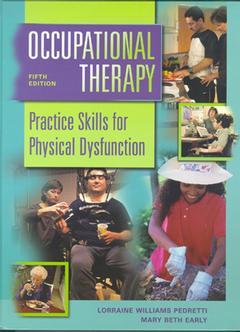Description
Occupational therapy. Practice skills for physical dysfunction, 5° Ed. 2001
Authors: PEDRETTI Lorraine Williams, EARLY Mary Beth
Language: English
Subject for Occupational therapy. Practice skills for physical...:
Approximative price 87.22 €
Subject to availability at the publisher.
Add to cart
Publication date: 02-2001
1080 p. · Hardback
1080 p. · Hardback
Description
/li>Contents
/li>
Now authored by two outstanding occupational therapy experts and 48 contributors who include educators, clinicians and leaders in their profession, Occupational Therapy Practice Skills for Physical Dysfunction 5th Edition, introduces occupation-based practice in the context of working with physical disabilities. It gives a comprehensive, in-depth overview of occupational therapy - history and theory, the occupational therapy process, evaluation and intervention inthe occupational performance areas, the performance components, interventions and treatment applications.
PART ONE: HISTORY AND THEORY FOR THE TREATMENT OF PHYSICAL DYSFUNCTION Occupational performance and models for practice for physical dysfunction History and practice trends in the treatment of physical dysfunction PART TWO: OCCUPATIONAL THERAPY PROCESS AND PRACTICE The occupational therapy process Treatment contexts Occupational therapy evaluation and assessment of physical dysfunction Treatment planning A model of evidence-based practice for occupational therapy Occupational therapy for prevention of injury and physical dysfunction Teaching activities in occupational therapy Documentation Infection control and safety in the treatment environment PART THREE: OCCUPATIONAL PERFORMANCE AND THE PERFORMANCE AREAS: EVALUATION AND INTERVENTION Occupational performance Activities of daily living Mobility Section 1: Functional Ambulation Section 2: Wheelchairs Section 3: Community Mobility Sexuality as an activity of daily living Work evaluation and work hardening ADA: accommodating persons with disabilities Leisure activities Assistive technology PART FOUR: EVALUATION AND INTERVENTION: THE PERFORMANCE COMPONENTS Functional motion assessment Joint range of motion Muscle strength Motor control Visual deficits Sensation and sensory dysfunction Evaluation and treatment of perceptual motor deficits Evaluation and treatment of cognitive dysfunction The social and psychological experience of having a disability Pain management PART FIVE: OCCUPATIONAL THERAPY INTERVENTIONS The Biomechanical Approach Therapeutic occupations and therapeutic modalities Orthotics Hand splinting Mobile arm supports and suspension arm devices The Sensorimotor Approaches The traditional sensorimotor approaches to treatment: an overview The Rood approach: A reconstruction Movement therapy: the Brunnstrom approach to the treatment of hemiplegia The proprioceptive neuromuscular facilitation (PNF) approach Neurodevelopmental treatment: the Bobath approach PART SIX: TREATMENT APPLICATIONS Cerebral vascular accident Traumatic brain injury Degenerative diseases of the central nervous system Dysphagia Spinal cord injury Neurogenic and myopathic dysfunction Arthritis Hand and upper extremity injuries Hip fractures and lower extremity joint replacement Low back pain Burns and burn rehabilitation Amputations and prosthetics Section 1: Body controlled prostheses Section 2: Electric controlled prostheses Section 3: Lower extremity amputations Cardiac and pulmonary diseases Oncology Special needs of the older adult HIV infection and AIDS Appendix Sample case studies Sample treatment plan form with permission for reproduction for classroom use.
© 2024 LAVOISIER S.A.S.

